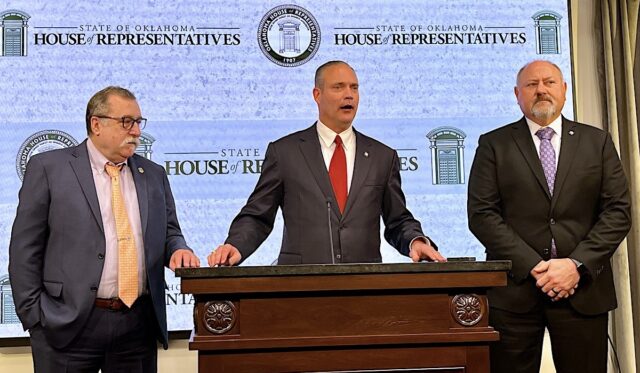
As has often been the case in recent sessions of the Oklahoma Legislature, a primary area of difference in House and Senate budget negotiations involves common education funding. To that end, the two chambers are around $115 million apart on crafting the State Department of Education budget for Fiscal Year 2025, but both proposals are relatively flat compared to last year’s historic increase.
According to a new budget transparency tool unveiled Tuesday morning, House Republicans currently hope to appropriate about $3.83 billion to the State Department of Education. Senators, meanwhile, propose around $3.94 billion.
“We know there will be some discussions. Our line items won’t line up directly with everything in the Senate’s proposal, nor in the governor’s proposal,” House Speaker Charles McCall (R-Atoka) said April 11. “But I think we will be close enough that we can get a budget agreement without a lot of theatre.”
Although both appropriation proposals are lower than what OSDE received last year, the department would not see a loss of funding. Lawmakers appropriated $160 million last year to fund three-year pilot programs for elementary reading specialists and school security programs, meaning that funding is not reflected in the Fiscal Year 2025 budget proposals being negotiated now. Meanwhile, both chambers intend to fund $16.6 million in flex benefit cost increases.
But OSDE is also unlikely to see a significant funding increase. Neither chamber has proposed adding money to the state’s funding equalization formula, which would mean last year’s massive increase would be funded but not amplified.
“Working with subcommittee chairs, the agency’s request and the caucus members as a whole, this is the House position,” said House Appropriations and Budget Committee Chairman Kevin Wallace (R-Wellston). “I do expect there to be some negotiations as we move forward.”
Thompson: ‘We will be defending our targeted investments’

Major differences in the chambers’ OSDE budget proposals primarily involve additional line-items sought by the Senate: nearly $100 million for a one-time support personnel stipend, $10 million designated for paid maternity leave mandated last year, and almost $3 million for paid student teaching.
“We do have targeted investments. We will be defending our targeted investments,” said Senate Appropriations and Budget Committee Chairman Roger Thompson (R-Okemah). “We realize that on the one-time stipend, that might be an uphill battle, but we’ll be defending those in budget negotiations.”
Budget details
View House & Senate proposals
Senate Education Committee Chairman Adam Pugh said he felt the support staff stipend is important because the Legislature does not set school support staff pay scales the way it sets minimum teacher pay requirements.
“When we gave that large infusion of cash into the funding formula last year, I was contacted by a number of support staff who said, ‘Hey, I didn’t get anything from that,'” said Pugh (R-Edmond). “Now, shame on those districts, but I felt like it was appropriate — without us getting into the pay scale — to say, ‘Hey, we value all the work you do inside a school district as well, and here’s money.'”
But House budget leaders said Tuesday that while they plan to negotiate with their counterparts, their opening position does not include those three Senate line items. Wallace said last year’s $625 million boost in common education formula funding was intended to empower “local control” about how that money would be used.
“At the local level, they have the funding to give or not give staff pay raises,” Wallace said. “It’s local control. The funding has been passed along (…) and that money is still in the base this year.”
Off the formula? Lingering FY24 concern becomes FY 25 issue

In an unusual turn of events, the biggest OSDE funding disagreements between Senate and House leaders this year involve how money was appropriated last year.
One aspect in the Oklahoma Legislature’s 2023 education deal included a requirement that all districts raise teacher salaries beyond whatever they were already paying. Both chambers said they intended for the FY 2024 budget to include funding for pay raises at districts “off” of the state aid formula.
While the concept can be confusing, districts that are off the formula receive enough local tax revenue — often from industrial properties such as wind farms or pipelines — that they do not receive funding from the state through the equalization formula. Whether a district is “on” or “off” the funding formula can change from year to year.
Although lawmakers said money would be provided to off-formula districts to cover the teacher pay raise last year, attorneys with OSDE identified a legal concern in an appropriation bill. As a result, $15 million has been held aside by OSDE, and both chambers have said more than $16 million needs to be sent as a supplemental appropriation now to fund the FY 2024 pay raise for off-formula districts.
But whether similar money should be paid on a recurring basis for FY 2025 and beyond is now a point of contention. Senate leaders say the funding was promised long term, but House leaders believe the allocation to off-formula districts should only be a one-time supplemental for FY 2024.
Answering questions about the situation at Tuesday’s House budget position press conference, Wallace said people need to understand “a point” about the state aid equalization formula.
“The reason the funding formula exists is for equality in per-pupil funding. Schools that are off the funding formula are receiving more money per average daily attendance per student than the formula schools, and that’s because of their local wealth in ad valorem dollars,” Wallace said. “It is imperative that we do not pull money out of the funding formula — taking it away from the poorer schools in the state to reward or benefit the richest schools in the state that are off the funding formula. That’s why the formula exists.”
Last week, Senate President Pro Tempore Greg Treat (R-OKC) acknowledged the House’s dislike of his chamber’s proposal to continue funding raises for teachers in off-formula districts.
“We have sent over a solution that they did not like,” Treat said. “They sent us over three drafts at 3:30 on Tuesday afternoon, which all made it abundantly clear that they don’t want to keep the commitment long-term on paying for that one pay raise for off-the-formula (school districts). That’s not the position that we committed to Oklahoma last year, so we are still working through some disagreements on it.”
But McCall and Treat seem to have differing views on last year’s deal.
“We’ve never funded off-formula schools. That’s why we have a funding formula,” McCall said Tuesday. “When we have done pay raises in the past, we have funded the off-formula schools one year for the teacher pay raise to give them the money to adjust their budgets.”
Last week, Treat said his understanding was that the Legislature would continue to fund the teacher pay raise for all districts.
“We funded, the Senate and the House, we funded — and the governor actually signed that one — that bill that fully funded the pay raise for all certified personnel,” Treat said. “We were very clear it was all certified personnel. (..) And we also did it for all schools, regardless of their status on the formula. That was actually a request from the House that we acquiesced to. And we agreed that we would pay that one single pay raise that we did last year in perpetuity on that. That’s at least what the Senate (was) understanding, and we told our members that.
“Evidently, they just wanted to keep that commitment for one year, and that was news to me this week. So that’s where we are at an impasse right now.”
Despite the disagreements, McCall emphasized the value of last year’s education deal, which saw an increase of more than $600 million in the education budget. McCall touted the deal as a way for districts to prepare for expiring pandemic-era federal funding.
“Last year, what we did was largely in response to several school districts reaching out to their House representatives concerned about that liquidity drying up,” McCall said. “We addressed that to a great extent last year in anticipation of that liquidity going away at the federal level.”





















